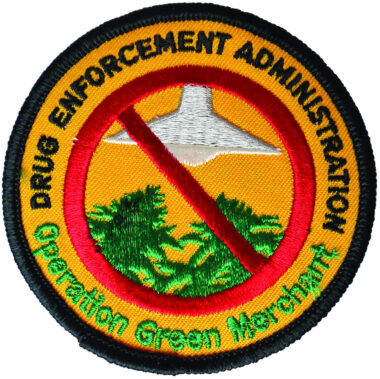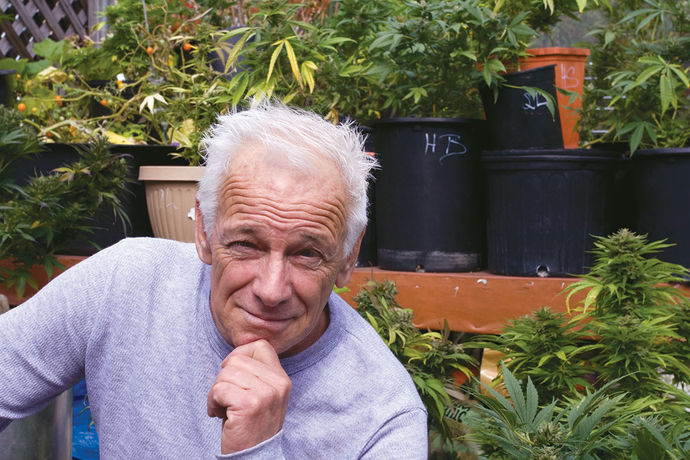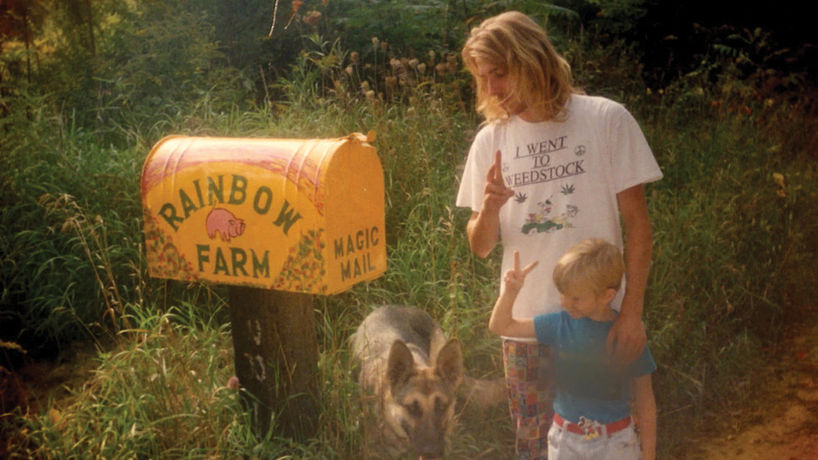
As Cannabis culture began shifting away from smuggling towards the “grow your own” philosophy at the end of the 1970s, a demand arose for more in-depth grow advice than what High Times offered at the time. From that vacuum, a new underground magazine emerged that would revolutionize Cannabis cultivation in America: Sinsemilla Tips.
RAID & REVENGE
Billed as “the nation’s only technical journal for the marijuana industry,” Sinsemilla Tips was created in 1980 by a grower named Tom Alexander as a sort of revenge fantasy against the establishment. Alexander had been living on a primitive 160-acre homestead in the backwoods of Corvallis, Oregon, where he planted around half an acre of quality Hawaiian genetics. But before he could harvest his first crop, a timber scout spotted his garden and reported it to the sheriff.
On September 27, 1979, 16 officers with semi-automatic rifles raided his homestead – confiscating his 1,200-plus plants and arresting him and his wife. Fortunately for them, the charges were ultimately dismissed due to an error on the search warrant regarding the location of his property. The authorities still kept his weed though, of course … and weeks later, three of the sheriffs involved were arrested by state police for attempting to sell it themselves. Unlike Alexander, however, who’d faced a $100,000 fine and possible 20 years in prison, the crooked cops were sentenced to just three years of probation.
Incensed by this blatant injustice, the outraged outlaw set out to exact his revenge on the establishment through the written word. He decided to write a book about Cannabis cultivation, but was quickly persuaded by his grower friends to publish an ongoing journal instead. Without a lick of experience in journalism or publishing, Alexander sat down with a typewriter, a kerosene lantern (he had no electricity), and some rubber cement and got to work. The result was a 16-page, typo-ridden newsletter that he christened Sinsemilla Tips.
TWO MOONS RISING
After printing around 1,000 copies, Alexander drove up and down the coast from Mendocino to Seattle selling the newsletters for 50 cents apiece at grow stores, on street corners, or wherever he could. It was while visiting those horticulture shops in Humboldt and Seattle that he noticed all of the growers with wads of hundreds buying fertilizers and grow lights, that he had another bright idea. One month after starting the journal, he opened Oregon’s first hybrid indoor/outdoor grow shop: Full Moon Farm Products.
“It was a 5,000-square-foot grow shop on Main Street in downtown Corvallis, right in front of everybody,” Alexander boasts. “It had windows that were 12 feet high, and we put grow rooms with 10-foot tomato plants in those two front windows to show what could be done with those lights.”

Upstairs from the Full Moon shop became the offices of New Moon Publishing, where he produced the magazine. Though unsophisticated in its design, Sinsemilla Tips began providing a wealth of groundbreaking cultivation information from the world’s top Cannabis experts, including Robert Connell Clark, Ed Rosenthal, Skunkman Sam, Michael Wolf Segal (originator of the now-legendary “sea of green” gardening method), and Jorge Cervantes.
“Jorge came into my store in 1983 and said, ‘I’m going to write a book on marijuana,’” Alexander recalls. “I said, ‘Well, come back when you finish it.’ Six months later, he comes back in and throws this book down, and I said, ‘Great – let’s go out back and smoke a joint,’ and we became best friends.”
Thanks to partnerships with Last Gasp publishing in San Francisco and Homestead Books in Seattle, the magazine’s reach soon expanded nationwide.
“Me, Jorge, David [Tatelman] of Homestead, Ron Turner at Last Gasp … we all became close-knit friends. They helped distribute the mag, and it just took off.”

SINSE SENSATION
On December 26, 1985, the New York Times published an article about Sinsemilla Tips entitled “Magazine for Ambitious Marijuana Growers.” That article led to more press, including appearances on Geraldo, Phil Donohue, Nightline and the Today show – thrusting Alexander into the spotlight as an outspoken new celebrity activist.

“In all those TV shows, I would be on stage with Charles Rangel and the head of the California DEA, and they would put forth totally ludicrous arguments, while I would be in a suit and tie looking presentable and making credible arguments. That really pissed them off.”
The publicity generated by the media coverage helped Sinse Tips go from an underground paper to a legitimate commercial magazine. Soon, Alexander was able to buy a new Mac, hire a staff, and up the publishing frequency from quarterly to bimonthly. By the late 1980s, the magazine was up to 72 pages, printing 10,000 copies, and grossing around $100,000 a year. With both his businesses booming, Tom Alexander seemed to be riding high … but sadly, his fortunes were about to change.
BLACK THURSDAY
On Oct. 27, 1989, DEA agents raided dozens of horticultural supply stores across 46 states and arrested over 100 people – a day of infamy in the Cannabis community that became known as Black Thursday.
“I was getting calls all morning from people on the East Coast saying, ‘I got the DEA here … my store’s being raided!’” Alexander remembers. “I got to the store about 8:00 a.m. and saw three unmarked cars in the parking lot with people sitting in them, and I said to myself, ‘Shit – they’re gonna hit me next!’”
Alexander entered through the back door, called his lawyer, and waited. When he opened his doors at 10:30 a.m., agents rushed in, followed by TV cameras, threw down a search warrant and began seizing his entire stock.
“They backed a U-Haul up to the store and just started taking out inventory,” Alexander laments.
OPERATION GREEN MERCHANT
The basis for these raids was a statute added to the Controlled Substances Act in the early 1980s that allowed for certain grow equipment to be classified as drug paraphernalia alongside bongs and pipes, provided that they were “intended” to be used to manufacture an illegal substance (marijuana). To establish that illicit intent, the DEA had conducted a two-year-long entrapment scheme codenamed Operation Green Merchant.

Starting in late ’87, the DEA sent undercover agents to dozens of grow stores – particularly, those who advertised in Sinse Tips and High Times – and asked workers there for information about growing marijuana. Aware of this possible legal jeopardy, most shop owners (Alexander included) gave explicit instructions to never discuss marijuana in their stores for any reason, and even to eject any customers who spoke of it. Unfortunately, employees at some shops failed to heed that warning; in the case of Full Moon Farm, the agents had posed as Vietnam vets with PTSD and persuaded some veterans working there into selling them equipment. These interactions provided the DEA with the legal justification needed to secure wiretaps, subpoena shipping records from UPS, and confiscate millions in merchandise.
In the case of Full Moon, authorities seized around $75,000 in merchandise – which, under the civil forfeiture laws, they were never required to return even though Alexander was never actually charged with a crime. Instead, the Feds offered him a simple ultimatum: sign an agreement relinquishing all rights to the merchandise and agreeing to never sell grow equipment again, or be charged with criminal conspiracy. Under advice from his lawyer – and pressure from his wife – he accepted the deal and closed the store.
AFTER THE FALL
Of course, Operation Green Merchant didn’t end after the busts of Black Thursday – the investigation soon expanded, attempting to link the shop owners in a criminal conspiracy with a prominent seed company in the Netherlands (that’s another story) and the marijuana mags in which they all advertised. Since the First Amendment prevented the Justice Department from targeting the publications directly, they simply shut down or scared off all of their advertisers in an attempt to starve them out instead. High Times managed to survive by eking out issues on a shoestring budget for a while, but sadly Sinse Tips was forced to fold – publishing their final issue in early 1990.
Luckily for him, Alexander had seen the writing on the wall: A year before Green Merchant, he’d started a separate, Cannabis-free magazine called Growing Edge, which was able to scoop up most of Sensi Tips’ former advertisers. He ran Growing Edge until retiring from publishing in 2009, then spent another decade serving as an expert witness for Cannabis cases and speaking at various conferences before finally leaving the world of weed behind.
“I’m out of the Cannabis industry now,” Alexander admits. “I don’t smoke anymore … I had a heart attack a year ago, and the smoke in my lungs cuts my oxygen, so my doctor told me to stick to tinctures and edibles. I had a good 45-year run, but now I’m done.”










